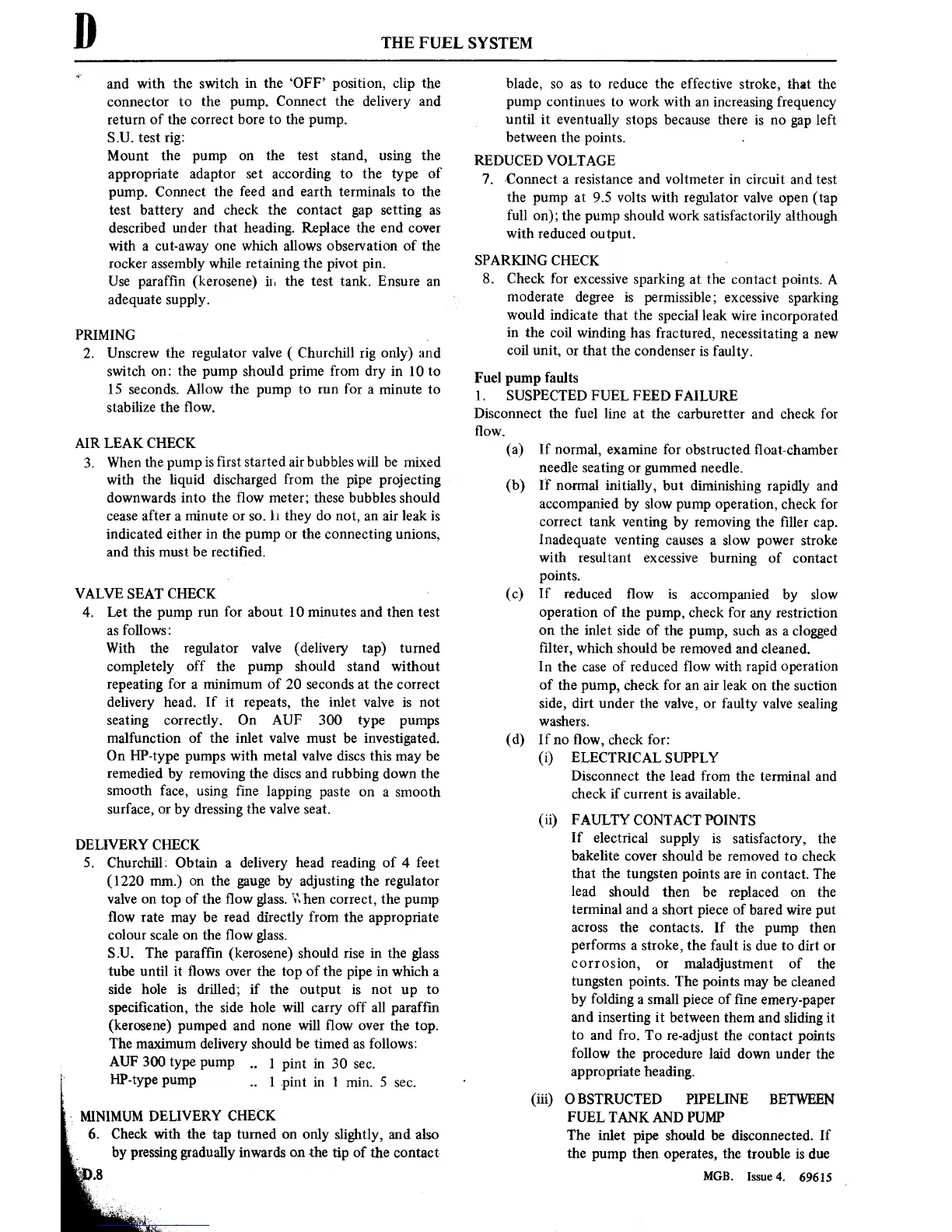D
THE FUEL
SYSTEM
and with the
switch
in
the ‘OFF’
position,
clip the
connector to
the
pump.
Connect the delivery and
return
of
the
correct
bore
to
the
pump.
S.U.
test
rig:
Mount
the
pump
on
the
test
stand,
using
the
appropriate
adaptor
set
according
to
the
type
of
pump.
Connect
the
feed
and earth terminals
to
the
test
battery and check
the
contact
gap
setting
as
described under
that heading. Replace the end
cover
with
a
cut-away
one
which aIIOWS
observation
of the
rocker
assembly
while
retaining
the
pivot pin.
Use
paraf■n
(kerosene)
in
the
test
tank. Ensure
an
adequate supply.
PRIMING
.
2.
Unscrew
the regulator valve
(
Churchill
rig
only)
and
switch
on:
the
pump
should
prime
from dry
in 10
to
15
seconds. Allow the
pump
to
run
for
a
minute
to
stabilize the ■ow.
AIR LEAK CHECK
3.
When the
pump
is
first started
air
bubbles will be
mixed
with the liquid discharged
from
the
pipe
projecting
downwards
into
the ■ow
meter;
these bubbles should
cease
after
a
minute
or so.
ll
they do
not,
an
air
leak
is
indicated either
in
the
pump or
the
connecting unions,
and this
must
be recti■ed.
VALVE SEAT CHECK
4. Let
the
pump run
for
about 10
minutes
and then
test
as
follows:
With
the regulator
valve (delivery tap)
turned
completely
off the
pump
should
stand without
repeating
for
a
minimum
of
20
seconds
at
the
correct
delivery head.
If
it
repeats,
the inlet valve
is
not
seating
correctly. On AUF
300
type
pumps
malfunction of
the inlet valve
must
be investigated.
On HP-type
pumps
with metal valve discs this
may
be
remedied by
removing
the discs and rubbing
down
the
smooth
face,
using
fine
lapping
paste
on
a
smooth
surface,
or
by dressing the valve
seat.
DELIVERY CHECK
5.
Churchill: Obtain
a
delivery head
reading
of
4
feet
(1220 mm.)
on
the
gauge
by adjusting the regulator
valve
on
top
of the ■ow glass. YWhen
correct,
the
pump
flow
rate
may
be read directly from
the
appropriate
colour scale
on
the ■ow glass.
S.U. The
paraf■n (kerosene)
should
rise in
the
glass
tube until
it
■ows
over
the
top
of
the
pipe in
which
a
side
hole
is
drilled; if the
output
is
not
up
to
speci■cation, the
side hole will
carry
off all
paraf■n
(kerosene)
pumped and
none
will
flow
over
the
top.
The
maximum
delivery
should
be timed
as
follows:
AUF
300
type
pump
1
pint in
30
sec.
HP-type
pump
1
pint in 1
min.
5
sec.
:
MINIMUM
DELIVERY
CHECK
6. Check with the
tap
turned
on
only slightly,
and also
by
pressing
gradually inwards
on
the
tip
of
the
contact
",8
blade,
so
as
to
reduce
the effective
stroke,
that the
pump
continues
to
work with
an
increasing
frequency
until
it
eventually
stops
because
there
is
no gap
left
between
the
points.
REDUCED VOLTAGE
7.
Connect
a
resistance
and voltmeter
in circuit
and
test
the
pump
at
9.5 volts with regulator valve
open
(tap
full on);
the
pump
should work satisfactorily
although
with reduced
output.
SPARKING
CHECK
-
8.
Check
for
excessive
sparking
at
the
contact
points.
A
moderate degree
is
permissible;
excessive
sparking
would indicate
that the
special leak
wire
incorporated
in
the
coil winding has fractured,
necessitating
a
new
coil
unit,
or
that
the
condenser
is
faulty.
Fuel
pump
faults
l.
SUSPECTED
FUEL FEED FAILURE
Disconnect
the fuel
line
at
the carburetter
and check
for
flow.
(a)
If
normal,
examine
for
obstructed
■oat-chamber
needle
seating
or
gummed
needle.
(b)
If
normal initially,
but diminishing rapidly
and
accompanied by
slow
pump
operation,
check for
correct
tank
venting
by
removing
the ■ller
cap.
Inadequate
venting
causes a
slow
power
stroke
with
resultant
excessive
burning of
contact
points.
(c)
If
reduced ■ow
is accompanied
by slow
operation
of
the
pump,
check for
any
restriction
on
the inlet
side
of
the
pump,
such
as a
clogged
■lter,
which should
be removed
and
cleaned.
In
the
case
of
reduced
■ow with rapid
operation
of the
pump,
check for
an
air
leak
on
the
suction
side,
dirt under
the valve,
or
faulty
valve sealing
washers.
(d)
If
no
flow,
check for:
(i)
ELECTRICAL
SUPPLY
Disconnect the lead from the
terminal and
check if
current
is
available.
(ii)
FAULTY
CONTACT POINTS
If electrical
supply
is
satisfactory, the
bakelite
cover
should be
removed
to
check
that the
tungsten
points
are
in
contact.
The
lead should
then
be replaced
on
the
terminal and
a
short
piece
of bared
wire
put
across
the
contacts.
If
the
pump
then
performs
a
stroke, the fault
is
due
to
dirt
or
corrosion,
or
maladjustment
of
the
tungsten
points.
The
points
may
be cleaned
by
folding
a
small
piece
of
■ne
emery-paper
and
inserting
it
between
them and sliding
it
to
and fro.
To
re-adjust the
contact
points
follow
the procedure laid down
under the
appropriate
heading.
(iii)
OBSTRUCTED
PIPELINE BETWEEN
FUEL
TANK AND PUMP
The
inlet
pipe
should
be disconnected.
If
the
pump
then
operates,
the trouble
is
due
MGB.
Issue4.
69615

